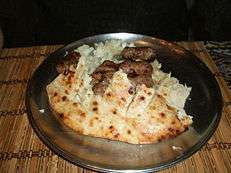Bosnia and Herzegovina cuisine
| Part of a series on the |
| Culture of Bosnia and Herzegovina |
|---|
 |
| History |
| People |
| Languages |
|
Mythology and folklore |
| Cuisine |
| Festivals |
| Religion |
| Art |
| Literature |
|
Music and performing arts |
| Sport |
|
Monuments |
|
Bosnia and Herzegovina cuisine (Bosnian: Bosanska kuhinja) is balanced between Western and Eastern influences. The food is closely related to former Yugoslav, Middle Eastern, Mediterranean and other Balkan cuisines.
Ingredients
Bosnian cuisine uses many spices, but usually in moderate quantities. Most dishes are light, as they are cooked in lots of water; the sauces are fully natural, consisting of little more than the natural juices of the vegetables in the dish. Typical ingredients include tomatoes, potatoes, onions, garlic, bell peppers, cucumbers, carrots, cabbage, mushrooms, spinach, courgette, dried and fresh beans, plums, milk, paprika and cream called pavlaka and kajmak. Typical meat dishes include primarily beef and lamb due to Islamic dietary laws, although the Bosnian Croats and Bosnian Serbs can consume pork. Some local specialties are ćevapi, burek, dolma, sarma, pilav (pilaf), gulaš (goulash), ajvar and a whole range of Eastern sweets. The best local wines come from Herzegovina where the climate is suitable for growing grapes. Plum or apple rakija, is produced in Bosnia.
Meat dishes
- Ćevapi – Bosnian kebabs: small grilled minced meat links made of lamb and beef mix; served with onions, kajmak, ajvar and Bosnian pita bread (somun)
- Pljeskavica - a patty dish
- Begova Čorba (Bey's Stew) – a popular Bosnian soup (chorba) made of meat and vegetables
- Filovane paprike or punjena paprika – fried bell peppers stuffed with minced meat
- Sogan-dolma – onions stuffed with minced meat
- Popara – bread soaked in boiling milk or water and spread with kajmak
- Ćufte – meatballs
- Meat under sač (meso ispod sača) – a traditional way of cooking lamb, veal, or goat under a metal, ceramic, or earthenware lid on which hot coals and ashes are heaped
- Pilav (pilaf) - grain, such as rice or cracked wheat, browned in oil, and then cooked in a seasoned broth
- Burek – a meat-filled flaky pastry, traditionally rolled in a spiral and cut into sections for serving. The same dish filled with cottage cheese is called sirnica, one with spinach and cheese zeljanica, one with squash/zucchini called tikvanica, and one with potatoes krompiruša. All these varieties are generically referred to as pita (Bosnian for "pie").
- Sarma – meat and rice rolled in pickled cabbage leaves
- Raštika - meat and rice rolled in kale leaves
- Grah – a traditional bean stew with meat
- Japrak – grape leaves stuffed with meat and rice
- Musaka – a baked dish made of layers of potatoes (or cabbage or egg plant)and minced beef
- Bosanski Lonac – Bosnian meat stew cooked over an open fire
- Tarhana - typical Bosnian soup with homemade pasta
- Sudžuk - (Sujuk) – spicy beef sausage
- Suho meso – air-dried meat similar to Italian bresaola
- Dolma - stuffed grape leaves with rice
Vegetable dishes
- Đuveč – vegetable stew, similar to the Romanian ghiveci and Bulgarian gjuvec
- Grašak – pea stew
- Kačamak – a traditional Bosnian dish made of cornmeal and potatoes
- Kljukuša – grated potatoes mixed with flour and water and baked in an oven; a traditional dish in the region of Bosanska Krajina
- Sataraš – a dish made with bell peppers, eggplants, onions and tomatoes
- Turšija – pickled vegetables
- Buranija - green beans soup. Can be cooked with meat and sometimes served with kajmak .
- Bamija
Appetizers
- Meze - an assortment of meats, vegetables, or other small dishes served before a meal
Cheeses
- Livno cheese - a dry yellow cheese from the west Bosnian town of Livno and surrounding villages
- Tešanjski– made from the nettle and milk, originates in the Tešanj district in northern central Bosnia and Herzegovina
- Travnički – a white feta-like cheese from the Travnik district in central Bosnia and Herzegovina
- Vlašićki – a highland cheese similar in its salty taste to Travnički, originates in the villages on Vlašić Mountain in central Bosnia and Herzegovina
- Suhi sir – a smoked cheese derived from posni sir
- Kajmak - a Turkish creamy dairy product, similar to clotted cream
- Pavlaka - a soured cream product like crème fraîche
Desserts
- Baklava
- Halva
- Bombica
- Hurmašica – date-shaped pastry drenched in a sweet syrup
- Jabukovača – pastry made of filo dough stuffed with apples
- Kadaif
- Krofna - filled doughnut
- Krempita
- Oblatna
- Orašnica
- Palačinka (crêpe)
- Pekmez
- Rahatlokum (Turkish Delight)
- Ružica – similar to baklava, but baked in a small roll with raisins[1]
- Ruske Kape (trans. Russian Caps, plural)
- Šampita - a whipped marshmallow-type dessert with fillo dough crust
- Sutlijaš (rice pudding)
- Tufahija – whole stewed apple stuffed with a walnut filling
- Tulumba - deep-fried dough sweetened with syrup
Relishes, seasoning and bread
Alcoholic beverages
Wines are produced mainly in Herzegovina, in the regions of Mostar, Čitluk, Ljubuški, Stolac, Domanovići, and Međugorje.
- Medovina
- Kruškovac
- Pelinkovac
- Rakija
- Blatina
- Žilavka
- Local spirits are distilled from plums, pears, or grapes, with alcohol content of 45% and higher.
- Šljivovica (plum brandy)
Non-alcoholic beverages
Kitchenware
Gallery
.jpg) Japrak from raštika
Japrak from raštika.jpg) Sarma
Sarma- Begova Čorba at Baščaršija.
- Sarajevski somun
- Sarajevo Ćevapi
- Sarajevo Ćevapi
- Cooked corn
- Cooked corn
- Boem šnita
- Bosanska Šnita
.jpg) Sarajevski rahatlokum (Fruit mix)
Sarajevski rahatlokum (Fruit mix) Bosnian alcoholic beverages
Bosnian alcoholic beverages- Somun bread (Sarajevski Ćevapi)
- Bosnian Ćevapi (Sarajevo)
- Lamb on the spit (Jablanica)
- Stuffed eggplant (Punjeni patlidžan)
- Stuffed peppers
- Cheese pie or cheese burek
- Spinach pie
- Bosnian pies in the shape of a wheel and strips
- Bosnian meat platters
- Spinach pie and cheese pie
- Tulumba (cross section)
- Bosnian pies
- Cream pie
- Lamb on the spit in Sarajevo
- Stuffed peppers, tomatoes, and zucchini, oven-baked
- Suho meso (Smoked meat)
References
- ↑ "Bakeproof: Bosnian baking". Sbs.com.au. Retrieved 12 December 2017.
- ↑ "Sarajevski somuni: Miris mahale, tradicije i savršenstva". klix.ba. 3 September 2015.
- ↑ "Ramazanski somun". moje-zdravlje.ba. 3 September 2015.
Further reading
- Tim Clancy, Bosnia & Herzegovina, The Bradt Travel Guide, 2004, pp. 93–97, ISBN 1-84162-094-7
- Darra Goldstein; Kathrin Merkle (eds.). Culinary cultures of Europe: identity, diversity and dialogue. Council of Europe. pp. 87–94. ISBN 92-871-5744-8.

